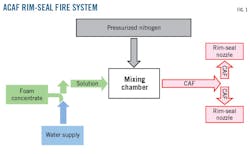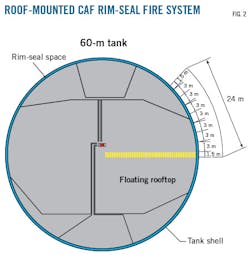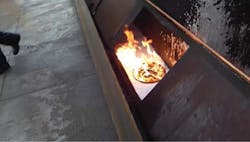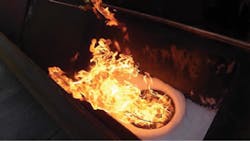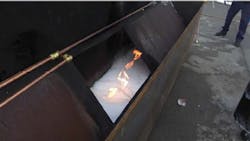Study confirms advance in rim seal fire control
Niall Ramsden
ENRg Consultants
Monks Risborough, UK
Khalid A. M. Abusaieda
Falck Fire Consulting Ltd.
Aylesbury, UK
A recently introduced foam system for extinguishing rim seal fires in floating-roof oil storage tanks demonstrated levels of fire control and extinguishment and burnback resistance the same as or arguably better than well‐designed conventional foam systems.
Large Atmospheric Storage Tank Fire (Lastfire) is an industry specialist forum of international oil companies reviewing the hazards and risks associated with large diameter storage tanks including open top floating-roof tanks. The group has collated a comprehensive database on tank fires as well, developing best practice guidance for fire risk reduction through feedback from members and research, including practical testing of systems and fire response equipment. Lastfire does not endorse particular products but does test fire protection equipment related to storage tanks and assess its performance.
This article describes results of performance tests on the compressed-air foam (CAF) Rimseal Fire Protection System carried out October 2014 at the Centro Jovellanos Training and Test Centre, Asturias, Spain. The tests were witnessed by Lastfire coordinators.
An earlier Lastfire meeting centered on presentation and discussion of the CAF rim seal system. Lastfire members said that testing to that point by the manufacturers had not included all possible scenarios and that additional work was required to assess its performance in relation to more conventional systems based on National Fire Protection Association (NFPA) 11 foam systems guidance. Particular concern was expressed regarding the fact that all foam discharge nozzles were mounted below the secondary seal. Group members noted that in some seal configurations residual fires could occur on seal materials, including fabric and elastomer, that might be at the top of the secondary seal and would not be extinguished using below-the-seal nozzles.
The test series discussed here evaluated different nozzle configurations to determine the particular seal configuration that could lead to top-of-seal fires.
Database
The Lastfire database, based on internal data provided anonymously by group members, shows that the most common type of fire on an external floating-roof tank is a rim seal fire. Rim seal fires should not cause the roof to sink and escalate to full surface fires in well-maintained tanks.
The only credible escalation routes based on analysis of incidents are pontoon explosions, which can lead to loss of roof integrity, and poor firefighting actions tilting or flooding roofs and causing them to sink or jam. Other ways to get a full surface fire include an initial incident such as ignition of liquid spilled on the roof leading to sufficient damage to sink it, or ignition of the fuel surface when the roof has already sunk due to operational or mechanical errors.
System
The tested CAF system mixes nitrogen and foam solution to make CAF which is then directed to the rim seal area to discharge through specially designed nozzles applying foam to the potential fire area (Fig. 1).
Although different configurations are available, a normal installation would include one or more self‐contained units mounted on the roof (Fig. 2). The system would be triggered by an automatic detector, normally a linear heat detector mounted in the rim seal area. The entire circumference of the tank is usually flooded with foam simultaneously but a sectionalized system can be provided if required.
The rim seal fire simulator at Centro Jovellanos Fire Training and Test Centre, Auturias, Spain, served as the test site (Fig. 3).
Follow-up
Lastfire members raised specific questions regarding the system and the amount of testing carried out, focusing on the following three points:
• If seal construction was such that combustible material like elastomers or fabric-reinforced elastomers were present above the discharge nozzles, for example at the top of any weather shield, Lastfire members felt that below-the-seal nozzles could allow residual fires in these materials to burn after foam discharge was completed.
• The initial presentation mentioned one specific type of foam. Group members wanted to know the performance that could be expected if other foams were used.
• Recognizing that normally the system would be discharged automatically and quite quickly, group members were interested in performance after a longer preburn period which, for example, could occur in the event of detection delay.
The discussed test series responded to these issues.
Test protocol
The rim seal fire training simulator at Centro Jovellanos served as the basis for the test set up (Fig. 3). This simulator is regularly used to train specialist hydrocarbon firefighters in rim seal fire response tactics using extinguishers and handlines.
The simulator consists of a roughly 10-m long, 500-mm wide trough section with a backplate. This simulates a 10-m long rim seal gap section between a tank roof and the tank shell, although it is wider than would normally be expected to allow a larger fire area. An inclined panel runs the entire length of the simulator from the top of the trough to the backplate, simulating a weather shield or secondary seal mechanism. There is a gap of about 50-mm along the length of the simulator between the top of the inclined plate and the backplate. The inclined weather shield includes dropdown removable panels to simulate damaged seal sections and allow greater air flow to the fire.
Resultant fires thus depict those that could include damage to seal sections and vapors escaping from gaps between the top of the secondary seal and the tank shell, typical of what might occur in practice. Fig. 4-5 show the simulator in operation.
An additional trough fitted to the simulator represented the foam dam and area between dam and roof edge. The foam dam was about 50 mm higher than the highest point of the weather shield on the simulator, in line with Lastfire and National Fire Protection Association (NFPA) 11 recommendations.
Installing the CAF discharge nozzles and associated pipework on a temporary basis at the required locations using hangers allowed them to be easily moved to assess different configurations. In this series of testing, four discharge nozzles were used in each test. Each nozzle had a flow rate of roughly 11.35 l./min foam solution, giving a total foam-solution flow rate of about 45 l./min. Foam expansion had previously been measured at a 12:1 ratio.
The fire measured 5 sq m, meaning the application rate was about 9 l./min/sq m. NFPA 11 sets a minimum application rate for hydrocarbon fires using CAF systems of 1.63 l./min/sq m. The minimum application rate for conventional foams for rim seal fires is 12 l./min/sq m.
Each test set a preburn time and the system was manually discharged when the preburn time was reached. Preburn timing began when the fire was first seen to encompass the complete length of the simulator. Initially, 150 l. of diesel and 50 l. of heptane were added to the simulator. In between tests residual foam was cleared and the fuels were topped off as required.
Test sequence, results
Table 1 shows the test sequence. In all tests the system extinguished the fire fully in an efficient and effective manner. The two foam types tested were considered high-quality versions of fluorine free (FF) and alcohol resistant aqueous film-forming foam (AR-AFFF), respectively. In the case of the AR-AFFF, the 1/3-type was used in the tests at a 3% proportioning rate.
The longer preburn times resulted in longer extinguishing times, but even with the longest preburn times extinguishment was achieved efficiently. Control times were not formally recorded because these are more subjective than extinguishment times, but it was noted that with longer preburn times fire control with only minor areas of fire still present were achieved relatively quickly compared to final extinguishment. In Test 2 for example, control to the state in which only a small section of fuel was still on fire was achieved in roughly 20 sec, compared with final extinguishment in 80 sec.
Foam produced during all the tests was very stable, with a long 25% drainage time. The FF foam's drainage time was longer than that of the AR‐AFFF.
Lighting a typical rim seal fire allowed testing of the various solutions (Figs. 4-5).
Test 1 stopped the system after 30 sec of operation (12 sec after extinguishment). The foam blanket was at least 100 mm deep. A burnback pot was positioned in the foam blanket (Fig. 6) and the foam removed from it. The exposed surface was ignited and allowed to burn. It was noted that although the foam near the burnback pot expanded (Fig. 7) there was no reignition of fuel outside the pot. The burnback pot was removed 13 min after extinguishment, the foam resealed, and the fire self‐extinguished (Fig. 8).
In other tests an igniter torch flame directed onto the foam blanket caused only minor damage to the foam blanket with direct flame impingement occurring in 15+ sec. This was the case for both foam types used.
Test 1 used burnback pots installed in the foam blanket (Fig. 6).
During above-seal tests the CAF nozzle clearly produced one downward and two sideways discharges. This multi‐discharge pattern was critical to the systems' efficiency. By the time the above-seal tests were carried out the nozzles were not as firmly fixed due to the temporary pipework hangers' lack of full support and distortion during other tests. Some nozzles were not properly aligned, showing some flexibility in positioning without significant loss of system performance.
Even when foam expanded outside the burnback pot, no reignition occurred during Test 1 (Fig. 7).
After extinguishment of Test 6 the system continued operating until the area between the tank shell and the foam dam was filled with foam, demonstrating the system's ability to build a deep foam blanket. This area was filled to maximum height in about 2 min. The foam blanket exhibited long drainage times and stability compared to conventionally made foams.
The fire extinguished itself within seconds once the burnback pot was removed (Fig. 8).
Bibliography
International of Oil & Gas Producers Association, "Fire System Integrity Assurance," Report No. 6.85/304, June 2000.
Lastfire, "Large Atmospheric Storage Tank Fires - A Joint Oil Industry Project to Review the Fire Related Risks of Large Open-Top Floating Roof Storage Tanks," Buckinghamshire, UK, 1997.
Lastfire, "Incident survey: Review of Escalation Mechanisms," Buckinghamshire, UK, 1997.
Lastfire, "Incident survey: Review of Escalation Mechanisms," Buckinghamshire, UK, 2012.
National Fire Protection Association, NFPA 11 "Standard for Low-, Medium, and High-Expansion Foam," 2016 edition.
The authors
Niall Ramsden ([email protected]) is project coordinator of the Lastfire Project, an international forum of oil storage companies. He holds a BSc (1973) in physics from the University of Kent, Canterbury, UK, and a PhD (1976) in mechanical engineering from Aston University, Birmingham, UK. He is a member of the Energy Institute, The Institute of Physics, the NFPA, and the Institute of Fire Engineers. Ramsden is a fully voting member the NFPA 11 Foam Systems Committee.
Khalid A. M. Abusaieda ([email protected]) is the quality, health, safety, environment and research and development manager at Falck Fire Consulting Ltd., Aylesbury, UK. He has also served as process safety consultant at the Libyan National Oil Corp. He holds a PhD (2012) from Loughborough University, Leicestershire, UK, and an MS (2003) from the University of Sheffield. He is a member of the Institution of Chemical Engineers.
